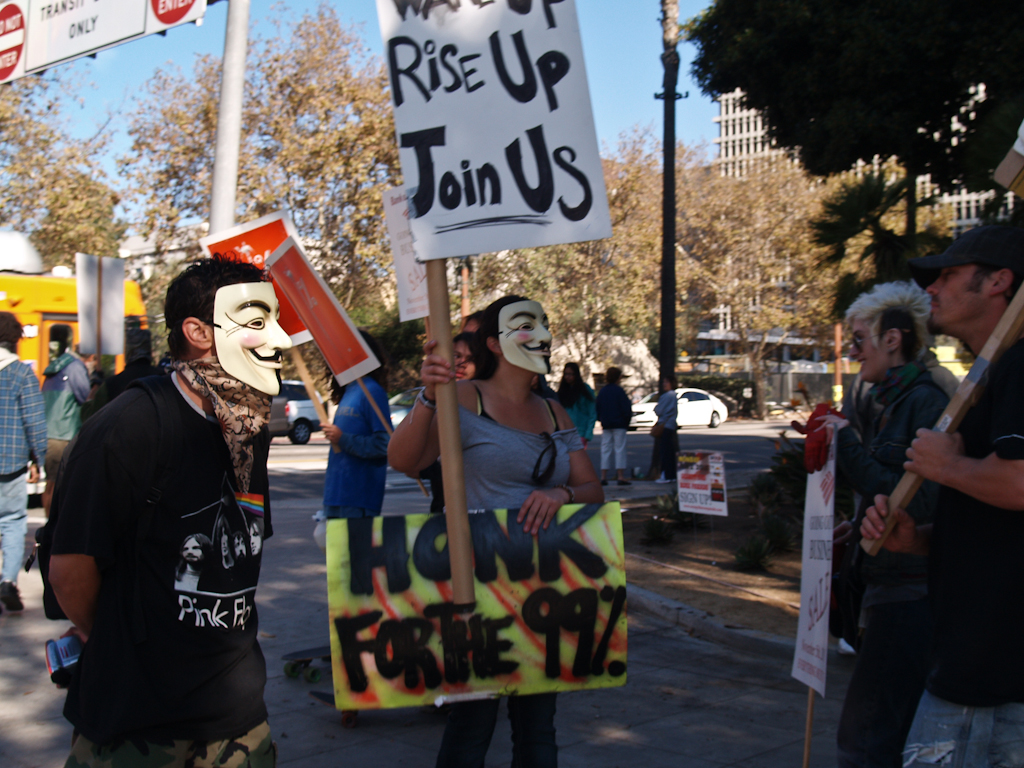
Occupy LA protesters wore Guy Fawkes masks inspired by the 2006 movie V for Vendetta on Saturday, November 5, 2011. Participants marched to commemorate bank transfer day. | Courtesy of Ashley Bornancin
The Occupy movement, birthed on Wall Street, is making its way across the globe — even to Los Angeles. A movement made up of people that identify themselves as the “99 percent,” Occupy L.A. is quickly becoming home to students. Aside from a small entourage that explored Occupy L.A. for the department of sociology’s Postmodern Metropolis class, few Biolans have been involved.
Reasons for protesting
On Saturday, Nov. 5, the main camp for Occupy L.A., stationed prominently in front of city hall, tingled with the idea of change. Regular protesters and visitors staged a march in honor of Bank Transfer Day, encouraging people to transfer their money from larger banking institutions to localized credit unions. Many activists carried signs and some wore masks depicting Guy Fawkes, a British anarchist who plotted to blow up the Parliament building on Nov. 5, 1605. The demographic of Occupiers ranged from children playing football to grandparents with walkers. Each had different reasons for occupying — foreclosures, better education and cleaner environment were a few examples.
Junior film major Justin Rood visited the Occupy camp on Nov. 4 with around 20 other students. The trip was a class activity for the students of Brad Christerson and Daniel Callis, Biola professors of sociology and art respectively.
“No one really knows what it is all about,” Rood said about Biola.
Rood reasoned part of this lack of involvement may be because Christian students feel compelled to submit to authority.
“At the same time,” he said. “I think it is really important to get out of the Biola bubble and really ask hard questions.”
Professors teach onsite
College students have played a significant role in Occupy Wall Street and its many offshoots.
On Wednesday, Nov. 2, Harvard University students left their Economics 10 class after writing an open letter to the professor.
“We are walking out of your class today both to protest your inadequate discussion of basic economic theory and to lend our support to a movement that is changing American discourse on economic injustice,” the letter stated.
The letter said that they would be joining a Boston-wide march to protest the “corporatization of higher education as part of the global Occupy movement.”
Occupycolleges.org reveals that 87 colleges are registered participants of the “teach-in” sessions.
In Los Angeles, “teach-ins” serve as part of what they call the People’s Collective University. There, professors from universities visit and teach about topics such as solar panels, self-sustainability and economics, explained Sam Resnick, a current student at Pasadena City College.
The Occupy Colleges movement began in California and was promoted through Twitter and Facebook. As of Nov. 9, their Facebook page had over 6,238 likes. Currently registered schools include the University of California Berkeley, California State University Long Beach, University of California Irvine, University of Southern California and Cerritos College in the nearby city of Norwalk.
The Occupy Colleges mindset challenges what students believe to be a narrow view of education. Callie Little graduated from Simmons College in Boston, Mass. in 2007 with a degree in economics and international relations. She now lives in Los Angeles and serves on the resources team for the Occupy L.A. movement.
“I feel like I had like this very quaint, cute, in-the-box, neo-liberal education,” Little said. “I basically feel like I’ve been unlearning everything that I learned in college since I graduated.”
Students and young people are committing to the Occupy movement full-time, beyond occupying college campuses. Despite being a student, Resnick spends much of his time at Los Angeles City Hall. After hearing about the Occupy movement from a friend, Resnick visited the Los Angeles location the second day after its inception.
“I just thought it was really cool, so I decided I would camp out as soon as I could and I’ve been doing it ever since,” he said.
His tent was originally pitched near the medical tent, so he began volunteering with them and continues to do so today. Resnick, who is studying history, says it’s been a little difficult to continue his studies while being so involved with Occupy L.A., but he feels he continues learning from everyone at the movement.
A variety of occupants
Christerson said that whether or not students agree with the tactics of the movement, they should realize that the issues being addressed are important.
While occupants’ motives vary from anti-military to environmentalism, Christerson stated that the core message looks at the gap between rich and poor and the lack of accountability in corporate powers.
“Scripture has a lot to say about this and actually has solutions for it,” Christerson said. “Not just for us as individual believers but for a society.”
Resnick hopes to see the movement on the same scale as the civil rights movement. He doesn’t see legislative change having any lasting effect, but instead, hopes to see a “a total social revolution that changes people’s perception about the way things work,” he said.
In concert with the Biblical approach, Christerson stated that the Occupy Colleges movement recently had an Azusa Pacific University professor lecture for a teach-in session on Jubilee economics.
Christerson is encouraged by the current idealistic generation that are engaged in social and justice issues and are caring for the marginalized.
“I went to college in the ’80s and it was all about getting a degree so you can make as much money as you can and that is still how a lot of people think,” Christerson said. “But there’s a larger percentage of students who are interested, I think, in making the world a better place.”







